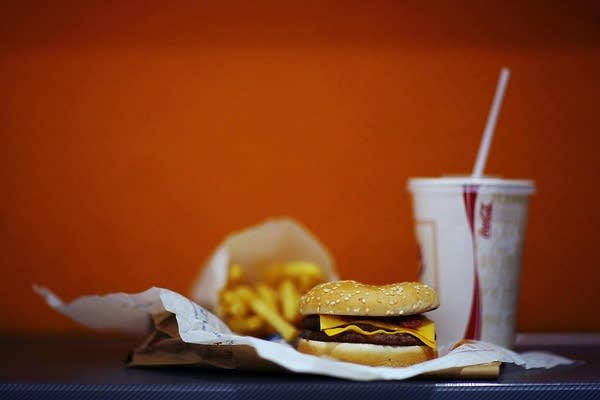Adults get 11 percent of calories from fast food
Go Deeper.
Create an account or log in to save stories.
Like this?
Thanks for liking this story! We have added it to a list of your favorite stories.

By MIKE STOBBE
AP Medical Writer
ATLANTA (AP) -- On an average day, U.S. adults get roughly 11 percent of their calories from fast food, a government study shows.
That's down slightly from the 13 percent reported the last time the government tried to pin down how much of the American diet is coming from fast food. Eating fast food too frequently has been seen as a driver of America's obesity problem.
For the research, about 11,000 adults were asked extensive questions about what they ate and drank over the previous 24 hours to come up with the results.
Turn Up Your Support
MPR News helps you turn down the noise and build shared understanding. Turn up your support for this public resource and keep trusted journalism accessible to all.
Among the findings:
• Young adults eat more fast food than their elders; 15 percent of calories for ages 20 to 39 and dropping to 6 percent for those 60 and older.
• Blacks get more of their calories from fast-food, 15 percent compared to 11 percent for whites and Hispanics.
• Young black adults got a whopping 21 percent from the likes of Wendy's, Taco Bell and KFC.
The figures are averages. Included in the calculations are some people who almost never eat fast food, as well as others who eat a lot of it.
The survey covers the years 2007 through 2010 and was released Thursday by the Centers for Disease Control and Prevention. The authors couldn't explain why the proportion of calories from fast food dropped from the 13 percent found in a survey for 2003 through 2006.
One nutrition professor cast doubts on the latest results, saying 11 percent seemed implausibly low. New York University's Marion Nestle said it wouldn't be surprising if some people under-reported their hamburgers, fries and milkshakes since eating too much fast food is increasingly seen as something of a no-no.
"If I were a fast-food company, I'd say `See, we have nothing to do with obesity! Americans are getting 90 percent of their calories somewhere else!'" she said.
The study didn't include the total number of fast-food calories, just the percentage. Previous government research suggests that the average U.S. adult each day consumes about 270 calories of fast food -- the equivalent of a small McDonald's hamburger and a few fries.
The new CDC study found that obese people get about 13 percent of daily calories from fast food, compared with less than 10 percent for skinny and normal-weight people.
There was no difference seen by household income, except for young adults. The poorest -- those with an annual household income of less than $30,000 -- got 17 percent of their calories from fast food, while the figure was under 14 percent for the most affluent 20- and 30-somethings with a household income of more than $50,000.
That's not surprising since there are disproportionately higher numbers of fast-food restaurants in low-income neighborhoods, Nestle said.
Fast food is accessible and "it's cheap," she said.




